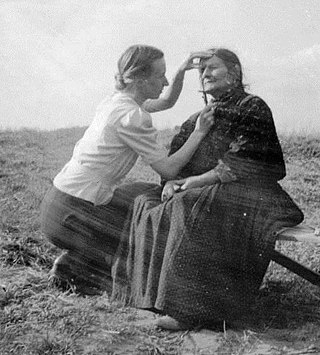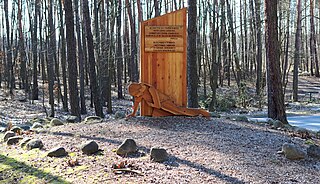Related Research Articles

Auschwitz concentration camp was a complex of over 40 concentration and extermination camps operated by Nazi Germany in occupied Poland during World War II and the Holocaust. It consisted of Auschwitz I, the main camp (Stammlager) in Oświęcim; Auschwitz II-Birkenau, a concentration and extermination camp with gas chambers; Auschwitz III-Monowitz, a labour camp for the chemical conglomerate IG Farben; and dozens of subcamps. The camps became a major site of the Nazis' Final Solution to the Jewish question.

The Final Solution or the Final Solution to the Jewish Question was a Nazi plan for the genocide of individuals they defined as Jews during World War II. The "Final Solution to the Jewish question" was the official code name for the murder of all Jews within reach, which was not restricted to the European continent. This policy of deliberate and systematic genocide starting across German-occupied Europe was formulated in procedural and geopolitical terms by Nazi leadership in January 1942 at the Wannsee Conference held near Berlin, and culminated in the Holocaust, which saw the murder of 90% of Polish Jews, and two-thirds of the Jewish population of Europe.

Nazi Germany used six extermination camps, also called death camps, or killing centers, in Central Europe during World War II to systematically murder over 2.7 million people – mostly Jews – in the Holocaust. The victims of death camps were primarily murdered by gassing, either in permanent installations constructed for this specific purpose, or by means of gas vans. The six extermination camps were Chełmno, Belzec, Sobibor, Treblinka, Majdanek and Auschwitz-Birkenau. Extermination through labour was also used at the Auschwitz and Majdanek death camps. Millions were also murdered in concentration camps, in the Aktion T4, or directly on site.

Heinrich Luitpold Himmler was a German politician who was the 4th Reichsführer of the Schutzstaffel, a leading member of the Nazi Party of Germany, and one of the most powerful men in Nazi Germany, primarily known for being a main architect of the Holocaust.

The Schutzstaffel was a major paramilitary organisation under Adolf Hitler and the Nazi Party in Nazi Germany, and later throughout German-occupied Europe during World War II.

Zyklon B was the trade name of a cyanide-based pesticide invented in Germany in the early 1920s. It consists of hydrogen cyanide, as well as a cautionary eye irritant and one of several adsorbents such as diatomaceous earth. The product is notorious for its use by Nazi Germany during the Holocaust to murder approximately 1.1 million people in gas chambers installed at Auschwitz-Birkenau, Majdanek, and other extermination camps.

The Romani Holocaust or the Romani genocide was the planned effort by Nazi Germany and its World War II allies and collaborators to commit ethnic cleansing and eventually genocide against European Roma and Sinti peoples during the Holocaust era.

The Sinti are a subgroup of Romani people. They are found mostly in Germany, France and Italy and Central Europe, numbering some 200,000 people. They were traditionally itinerant, but today only a small percentage of Sinti remain unsettled. In earlier times, they frequently lived on the outskirts of communities.

The Holocaust—the murder of about six million Jews by Nazi Germany from 1941 to 1945—is the most-documented genocide in history. Although there is no single document which lists the names of all Jewish victims of Nazi persecution, there is conclusive evidence that about six million Jews were murdered. There is also conclusive evidence that Jews were gassed at Auschwitz-Birkenau, the Operation Reinhard extermination camps, and in gas vans, and that there was a systematic plan by the Nazi leadership to murder them.

The Nuremberg Laws were antisemitic and racist laws that were enacted in Nazi Germany on 15 September 1935, at a special meeting of the Reichstag convened during the annual Nuremberg Rally of the Nazi Party. The two laws were the Law for the Protection of German Blood and German Honour, which forbade marriages and extramarital intercourse between Jews and Germans and the employment of German females under 45 in Jewish households; and the Reich Citizenship Law, which declared that only those of German or related blood were eligible to be Reich citizens. The remainder were classed as state subjects without any citizenship rights. A supplementary decree outlining the definition of who was Jewish was passed on 14 November, and the Reich Citizenship Law officially came into force on that date. The laws were expanded on 26 November 1935 to include Romani and Black people. This supplementary decree defined Romani people as "enemies of the race-based state", the same category as Jews.

The inverted black triangle was an identification badge used in Nazi concentration camps to mark prisoners designated asozial ("asocial") and arbeitsscheu ("work-shy"). The Roma and Sinti people were considered asocial and tagged with the black triangle. The designation also included alcoholics, beggars, homeless people, nomads, prostitutes, and violators of laws prohibiting sexual relations between Aryans and Jews. Women also deemed to be anti-social included nonconformists.

Berlin-Marzahn Rastplatz was a camp set up for Romani people in the Berlin suburb of Marzahn by Nazi authorities.

Eva Justin was a German anthropologist who was active during the Nazi era. She specialised in scientific racism. Her work contributed to the Nazi crimes against the Sinti and Roma peoples.

The organization of underground resistance movements in Auschwitz concentration camp began in the second half of 1940, shortly after the camp became operational in May that year. In September 1940 Witold Pilecki, a Polish army captain, arrived in the camp. Using the name Tomasz Serafiński, Pilecki had allowed himself to be captured by Germans in a street round up (łapanka) with the goal of having himself sent to Auschwitz to gather information and organize resistance inside. Under Pilecki's direction the Związek Organizacji Wojskowej, ZOW, was formed.

Ernst-Heinrich Schmauser was a German Nazi Reichstag deputy and SS-Obergruppenführer who was the Higher SS and Police Leader (HSSPF) in Breslau during World War II. He was responsible for the death march from Auschwitz–Birkenau concentration camp, in which upwards of 25 percent of the prisoners were killed. In the last months of the war, he was captured by the Red Army and presumed killed.

The Roma Holocaust Memorial Day is a memorial day that commemorates the victims of the Romani genocide (Porajmos), which resulted in the murder of an estimated 220,000–500,000 Romani people by Nazi Germany and its collaborators during World War II. The date of 2 August was chosen for the memorial because on the night of 2–3 August 1944, 2,897 Roma, mostly women, children and elderly people, were killed in the Gypsy family camp (Zigeunerfamilienlager) at Auschwitz concentration camp. Some countries have chosen to commemorate the genocide on different dates.
Margarete Kraus was a Roma woman who was persecuted during the Porajmos, imprisoned at Auschwitz and Ravensbruck. Her experience was recorded in later life by the photographer Reimar Gilsenbach.
Elisabeth Guttenberger was a German Holocaust survivor and human rights activist. Of Sinti origin, she survived the Romani Holocaust and testified at the Frankfurt Auschwitz trials after having been interned at the Gypsy family camp.

Philomena Franz, née Köhler was a Sinti writer and activist from Germany, who was a survivor of the Romani Holocaust, having been imprisoned in Auschwitz. She later published works that recounted her experiences and was recognised as a significant voice in Romani literature.
Melanie Spitta was a German Sinti film-maker.
References
- Notes
- Citations
- ↑ Bauer 1998, p. 447.
- ↑ Longerich 2012, p. 670.
- 1 2 Rees 2005, p. 248.
- 1 2 Steinbacher 2005, p. 110.
- ↑ Steinbacher 2005, p. 111.
- 1 2 Rees 2005, p. 251.
- ↑ Epstein 2015, p. 165.
- ↑ Hancock 1997, p. 339.
- ↑ Katz, Brigit. "London Library Spotlights Nazi Persecution of the Roma and Sinti". Smithsonian Magazine. Retrieved 2021-04-05.
- Bibliography
- Bauer, Yehuda (1998) [1994]. "Gypsies". In Gutman, Yisrael; Berenbaum, Michael (eds.). Anatomy of the Auschwitz Death Camp. Bloomington: Indiana University Press. pp. 441–455.
- Epstein, Catherine (2015). Nazi Germany: Confronting the Myths. John Wiley & Sons. ISBN 978-1-118-29479-6.
- Hancock, Ian (1997). "A Glossary of Romani Terms". American Journal of Comparative Law . 45 (2): 329–344. doi:10.2307/840853. hdl:2152/31217. JSTOR 840853.
- Longerich, Peter (2012). Heinrich Himmler: A Life. Oxford; New York: Oxford University Press. ISBN 978-0-19-959232-6.
- Rees, Laurence (2005). Auschwitz: A New History . New York: Public Affairs, member of Perseus Books Group. ISBN 1-58648-303-X.
- Steinbacher, Sybille (2005) [2004]. Auschwitz: A History . Munich: Verlag C. H. Beck. ISBN 0-06-082581-2.